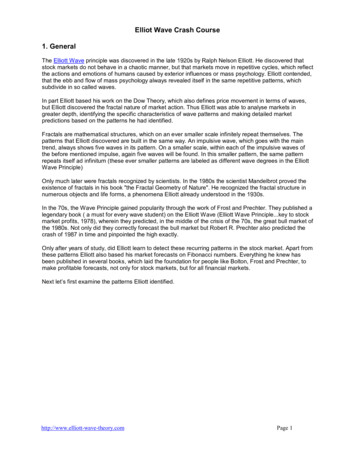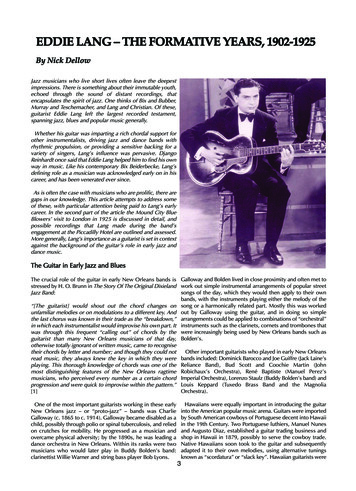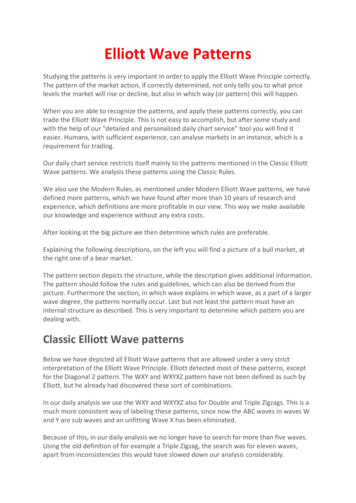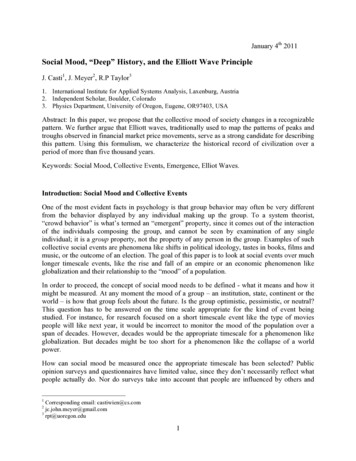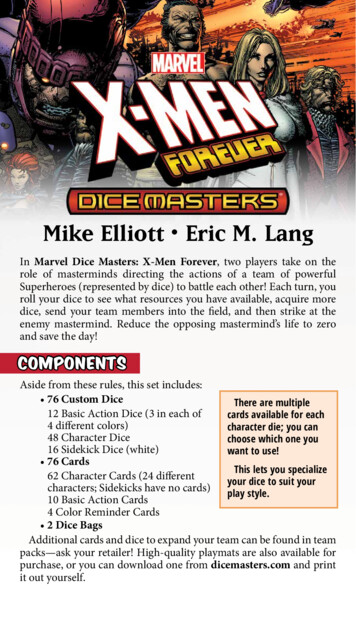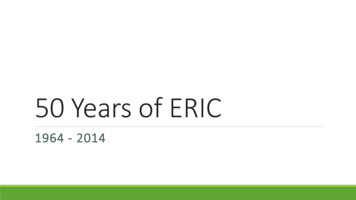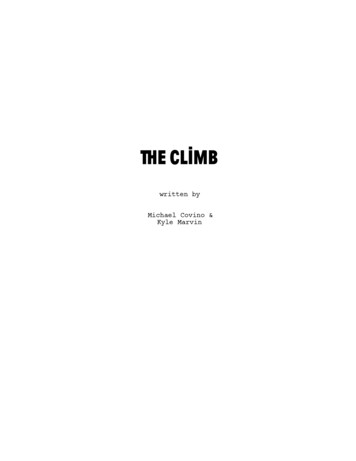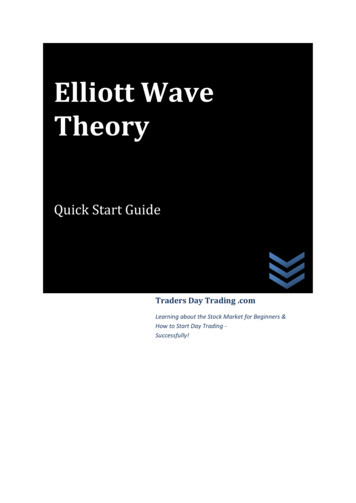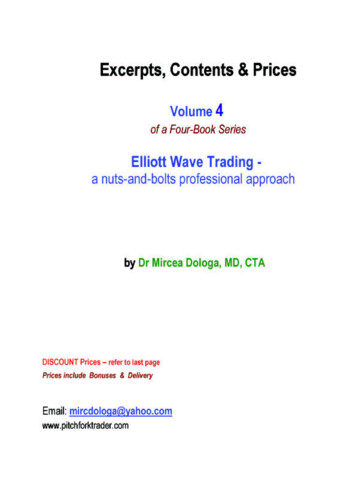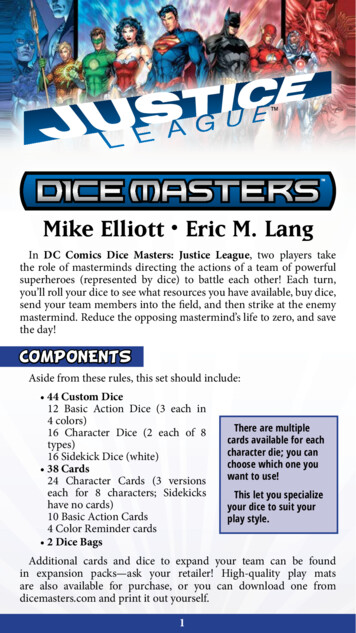
Transcription
Mike Elliott Eric M. LangIn DC Comics Dice Masters: Justice League, two players takethe role of masterminds directing the actions of a team of powerfulsuperheroes (represented by dice) to battle each other! Each turn,you’ll roll your dice to see what resources you have available, buy dice,send your team members into the field, and then strike at the enemymastermind. Reduce the opposing mastermind’s life to zero, and savethe day!COMPONENTSAside from these rules, this set should include: 44 Custom Dice 12 Basic Action Dice (3 each in4 colors)16 Character Dice (2 each of 8 types)16 Sidekick Dice (white) 38 Cards24 Character Cards (3 versions each for 8 characters; Sidekickshave no cards)10 Basic Action Cards4 Color Reminder cards 2 Dice BagsThere are multiplecards available for eachcharacter die; you canchoose which one youwant to use!This let you specializeyour dice to suit yourplay style.Additional cards and dice to expand your team can be foundin expansion packs—ask your retailer! High-quality play matsare also available for purchase, or you can download one fromdicemasters.com and print it out yourself.1
CARDSEach card details all the powers of one set of dice. Cards and theirassociated dice come in two types: characters and actions. Charactersare named after people in the DC Universe (Sidekicks are theexception, and represent the people who have no special powers, butare nonetheless helpful), and their dice have numbers around the faceswith the custom symbol. Actions are named for events or activities,and have no numbers around the die’s custom symbol.At the top center of the card is the card’s title and subtitle. Mostcards have several versions that are differentiated by their subtitle.At the upper left of the card is the die’s cost (a number) and energy, or shield ). Cards oftype (a symbol of a bolt , fist , maska given energy type require that energy to be purchased, and providethat type of energy during play. Superman (shown in the diagrambelow) is a shield character that costs 7. Sidekicks and Basic ActionCards have no energy type.Below the cost and energy type, some characters have a team logo toidentify their affiliation (action dice have no affiliation).The affiliation is shown by the team’s logo:Justice LeagueJustice Societyof AmericaLegion of DoomVillainsCollectorNumberCost & TypeAffiliation(very small)Card Name &SubtitleCard ArtRarity Stripe(see page 25 for“Rarity” )Text BoxDie FaceReferenceDie Limit(energy faces)(character faces of increasing level)The text box in the center of the card details the die’s abilities. Belowthat, the color of the rarity stripe provides information for collectors.2
Right below the rarity stripe, “Max:” number shows the die limit;that’s how many of these dice you are allowed to have in a team. (Basiccards have “Use:” because you always use a fixed number of them inevery game.)At the bottom, the die face reference shows the various faces of thedie. Faces that provide energy are on the left, and character or actionfaces are on the right.DICEEach die is engineered with a unique combination of colors andgraphics.All dice have faces that generate energy.Energy faces have one or two of thespecial energy symbols on them. We talkmore about energy on page 6.The special sides on action dice have acustom icon, and some have one or twoburst symbols on them. Action dice neverhave numbers.Character dice have a custom icon and may have burst symbols,but they always have several numbers that define the character’s basicabilities.FieldingCostAttackBurst(s)(if any)DefenseCustom IconThe number in the topleft is the fielding costof the die. This is howmuch energy you mustspend to send the dieinto the field where it canengage the forces of youropponent.At the top right is the die’s attack; this is how much hurt it dishes out.On card text, a die’s attack is abbreviated as A.The bottom right shows the die’s defense; how much damage it takesto knock the character out. On card text, defense is abbreviated as D.The bottom left may have one or two burst symbols. These activatespecial abilities on dice, if any are listed. If no burst abilities are listedon the card, the burst has no effect.Dice on their energy faces can move from your Reserve Pool to payfor costs. If they do that during your turn, they go Out of Play (theyare moved to your Used Pile at the end of the turn). If it isn’t your turn,they go straight to your Used Pile.3
SETUPHow you set up depends on whether or not this is a demo game(for you or a friend). If you’re just learning or teaching a new player,you should give the setup below a try. If you’re an experienced DiceMasters player, feel free to skip to Customizing Your Team on page24 of this booklet.A DEMO GAMEFor this demo game, place the following Basic Action Cards in thecenter of the play area: Anger Issues, Phantom Zone, Villainous PactPut a set of three Basic Action Dice on each of those cards (it doesn’tmatter which color, but this example will refer to them as if you hadused red, blue, and green in order). Place the Red Dice reminder cardunder Anger Issues with the label sticking out from the top or side ofthe card. Do the same with the Blue Dice card and Phantom Zone, andthe Green Dice card with Villainous Pact. These cards will help playersremember which dice use which card when all the dice on a BasicAction Card have been purchased.Basic Action Cards can be used by either player, no matter whobrings them! In this demo game, we don’t specify who brought themanyway.Decide who goes first by flipping a coin or rolling a die (one playercould call energy or character while the other player rolls the die).The player who wins the coin toss or die roll can choose to go first orsecond. Each player gathers the cards listed below and the two dicethat match them. Every character in this starter has 3 versions, so besure to grab the right one based on the subtitle. First Player: Martian Manhunter, J’onn J’onnz, and Batman ,The Dark Knight Second Player: Wonder Woman, Champion of Themyscira,and Zatanna, arataZ annataZ.Place those cards, each with their two matching dice, on your side ofthe table. These cards, unlike Basic Actions, can only be purchased bythe player whose cards they are. Your play space should look like thediagram on page 5.Finally, each player takes 8 of the Sidekick dice (this starter comeswith 16) and places them in one of the dice bags (this starter comeswith 2). Each player will start the game with 10 life for this demo game.4
When you’re set up, thetable should look sort oflike this:PLAY AREASThere are several distinct areas where you place your dice to indicatewhat they can and can’t do for you.The Bag: One of the two dice bags provided (or your own bag). Thisis where you draw dice from. If your bag is ever empty, and you needto draw a die, move all dice from your used pile into your bag andshake it well to mix the dice thoroughly.Prep Area: This area holds dice that you’ll roll during your roll andreroll step in addition to the dice from your draw. This is where KO’ddice go.Reserve Pool: These are dice that you have rolled but have not yetdone anything with. Dice on energy faces here can be spent, dice onaction faces can be used for their effects, and dice on character facescan be fielded.Field: This is where characters go. Sometimes you’ll be payingtheir fielding cost to get them here, other times they’ll be using theirabilities from here.5
Attack Zone: This is a special part of the Field Zone. It’s whereyour characters go when you assign them as attackers or blockers.Characters in the Attack Zone are also in the Field Zone.Out of Play: Nothing can happen to dice here. Energy spent duringyour turn goes here, so do action dice you use during your turn orunblocked characters.Used Pile: Dice here have been used up. At the end of your turn, alldice Out of Play are moved here. When you spend energy during youropponent’s turn, it goes directly here. Dice here are returned to yourbag when you would try to draw a die but cannot.HOW TO PLAYFirst we’ll outline the basic structure of the game. Later we’ll havemore detailed rules that should be referenced when questions arise.Each player has a certain amount of life points at the start of thegame (this is 10 points in the demo; when you play a full game with 20dice you’ll use 20 life). Keep track of your life total with a method ofyour choice like a piece of scrap paper or using the track in the centerof this booklet.During the game, you’ll want to purchase character dice and actiondice. Character dice can be sent to the field to attack your opponent,they can stay in your field zone to block, or sometimes they can evenuse special abilities. Unblocked characters can damage your opponent,reducing his or her life. When you reduce your opponent’s life to zero,you win!ENERGY AND COSTSDice can produce energy. The Sidekick dice you start with canproduce all different types of energy; some dice will even producemore than one energy. Energy allows you to buy additional dice, payto field characters, and pay for Global Abilities (we’ll explain all thesesoon).There are five types of energy: Fist Bolt Mask ShieldIn addition, some other die faces provide energy: Wildcard ( ) – may be used as any type of energy) – provides two energy, but of no particular type G eneric ( Doubles – some faces will provide two Fists, two Masks, etc. byshowing two of that symbol6
CARDS AND DICESidekicks have no cards associated with them. Basic Action Dice canbe paired with any of the Basic Action Cards and an indicator card.All other dice are associated with a few cards. Before playing, you’llchoose one of those cards to use with each type of die. The card givesa variety of details about the die, such as its cost, its special abilities,and its faces in order.Characters have levels (normally three). These levels are the diefaces that show the die’s custom symbol and the character stats. Theleftmost character die face shown on the die’s card is level 1. The levelincreases by one for each face moving to the right. In the top left ofeach character face is a number: that is the cost to field that character.In the top right is that character’s attack (often referred to as A in cardtext). Below a character’s attack is its defense (often referred to as Din card text). Burst SymbolsMany dice have a burst symbol ( ) or two burst symbols() in the lower left corner of one or more of their faces. Theseburst symbols indicate that the die might activate some sort of specialeffect. When you roll a face that has one or two burst symbols onit, you must apply the matching text on the card (you can’t choosenot to). If there is no corresponding text on the card, then the burstsymbol has no effect.TURN ORDERPlayers alternate taking turns. During a player’s turn, that playergoes through the following steps in order. Once a step is completed, aplayer cannot go back to it in the same turn.CLEAR AND DRAW STEPMove all dice still in your Reserve Pool to your Used Pile. Since theywere never used, they do not go Out of Play, but move directly to yourUsed Pile.Draw 4 dice from your bag. If your bag has fewer than 4 dice, drawall of them, then place all the dice from your Used Pile into the bag,shake the bag well, and continue drawing until you have drawn 4 dicetotal. Sometimes cards or abilities will make you draw more dice: drawthose additional dice now. Place all dice drawn into your Prep Area.If, after refilling the bag, you are only able to draw 3 dice or fewer,lose 1 life and gain 1 generic energy for each die below four that youdrew. For example, if you only drew 3 dice from the bag, you wouldgain 1 generic energy and lose 1 life.7
ROLL AND REROLL STEPRoll the dice you drew from the bag as well as all of the dice that werealready in your Prep Area (that were placed there in an earlier turn).After you have rolled your dice, you may choose to reroll any or allof them. When rerolling, you select all of the dice to reroll at once, andyou reroll them as a group.You do not get a second reroll opportunity even with dice that youdid not choose for your first reroll.Once you’ve rolled (and possibly rerolled) all of your dice, place allof the dice you rolled into your Reserve Pool, keeping the same faceup.MAIN STEPDuring this step, you may purchase dice, activate Global Abilities,field characters, and use Action Dice. You can do these multiple timesand in any order; for example, you could purchase a die, use an action,field a character, and then purchase another die. Spending Energy Purchasing a DieTo pay energy during your turn, move dice showing that muchenergy from your Reserve Pool Out of Play. Those dice will go toyour Used Pile during Cleanup. You can also pay energy during youropponent’s turn, but that energy goes directly into your Used Pile.On your turn, you can purchase any combination of dice you like.You can purchase dice from the Basic Action Cards in the center (nomatter which player brought them), as well as from the cards youbrought to the game.To purchase a die, you must pay its purchase cost in energy. If thecard shows that it is a certain energy type, at least one of the energyused to pay that cost must be that type of energy.Example: Green Arrow, Oliver Queen, has a cost of 4 and is acharacter. You can buy a Green Arrow die with a and three , or a, two , and a, etc. Villainous Pact does not show an energy typenext to its cost; you can use any type of energy to pay for a VillainousPact die.When you’ve bought dice, they go to your Used Pile.If you have a die that produces two or more non-generic energy, youmay partially spend the die’s energy by spinning it down to a face thatreflects the unused portion of the die’s energy. For example, if a dieyou may use theand another energy to purchaseface shows8
adie that costs two and change the face on the die to a face that. This only applies to symbol dice and not dice that produceshowsgeneric energy. For generic-energy dice, any unused portion that isnot immediately spent is lost. However, you can purchase multipledice simultaneously to spend a generic die completely. Using a Global AbilitySome cards have Global Abilities printed on them. These effects arealways available, whether or not a die from that card is in the field. Youcan use a Global Ability listed on an opponent’s card even though youcannot purchase a die from that card.During a player’s main step, both players can use any or all GlobalAbilities available. To use a Global Ability, you must pay the energycost, moving the die or dice used to pay that cost to your Used Pile(if it’s your turn, they are therefore Out of Play). In many cases, theseeffects may be used more than once if the cost can be paid multipletimes. As with purchasing dice, you can partially spend non-genericenergy. If both players want to use a Global Ability at the same time,the player whose turn it is wins the tie. Playing Actions Field CharactersYou may use the action faces on your action dice during the MainStep. To do so, apply the effect and then move the action die from yourReserve Pool to Out of Play (it will go to your Used Pile at the end ofthe turn). It costs no extra energy to use an action die.It costs energy for you to send your character dice from your ReservePool to the field, though in some cases, that cost is zero.When you field a character, you must pay energy equal to thecharacter’s fielding cost as shown in the upper left corner of the die.This cost can be paid with any type of energy, even generic. As withpurchasing dice, you can partially spend non-generic dice, and youcan pay more than one cost at once to fully spend a generic-energy die.You cannot field a character if you cannot pay the energy cost.Many characters have game effects that take place when they arefielded. Some of these effects target dice in your Used Pile. Such gameeffects cannot target or select a die that was used to pay for fielding thecharacter, since dice that enter your dice from the Reserve Pool areOut of Play for the rest of the turn.You are not required to field a die if you do not wish to. Anycharacters that you do not field (because you can’t or choose not to) bythe end of the Main Step go to your Used Pile (they do not go Out ofPlay, since they were never used).9
ATTACKAfter you have completed all your activity in the Main Step andmoved leftover characters from your Reserve Pool to your Used Pile,you are ready to attack. During the Attack Step, the attacking playercan use any actions still in the Reserve Pool. In addition, both playerscan use Global Abilities whenever appropriate; that is, they can useGlobal Abilities that react to damage and the like when that happens.All other Global Abilities can be used after blockers are declared.The Attack Step has the following parts, in order: Declare AttackersAny or all of your fielded characters can attack. Move thesecharacters into the Attack Zone. It costs no energy to move a characterinto the Attack Zone; it is just a part of the Field Zone. You can sendall, some, or none of your characters to attack. If you do not attack,your turn immediately ends (neither player can use Global Abilitiesin this case).After you declare all attackers, apply any effects that happen due tocharacters attacking. Declare BlockersYour opponent declares blocking characters, moving them into theAttack Zone and assigning each one to block a specific attacker. Youropponent can block with all, some, or none of his or her characters.A single blocker can only block one attacking character: it can’t blockmore than one. However, more than one blocker may be assigned toblock a single attacker.After all blockers are declared, apply any effects that take place dueto blocking or being blocked. As is the case with all ties, the playerwhose turn it is (the attacker) resolves first, then the defender. Use Actions and Global Abilities Assign DamageThe attacking player can use action dice and Global Abilities; thedefending player can use Global Abilities. If both players have sucheffects that they wish to use, the attacking player gets to go first. Onceboth players are finished, move on to assigning damage.Both players assign damage. Damage occurs simultaneously. (Inthe rare case where it is relevant, the attacking player assigns first,although damage still resolves simultaneously.)Each attacking character that was blocked assigns its attack valuein damage to the character(s) blocking it. If more than one character10
is blocking an attacking character, the attacker can choose how todivide the damage between the blockers (and can even assign one fulldamage and the other zero). An attacking character must assign all ofits damage. Likewise, each blocking character assigns damage equalto its attack value to the character it blocks (characters that can blockmore than one attacker must split their damage as an attacker would).Damage dealt to a character in excess of its defense has no effect.Attacking characters that were unblocked (or those with specialabilities) assign damage to the defending player instead of a character.That damage will be deducted from the player’s life total. Theseunblocked characters are moved Out of Play, after dealing damage,before any other effects resolve other than those that would replacedamage. They’ll go to the Used Pile during Cleanup.Once all damage has been assigned, knock out each character thattook damage greater than or equal to its defense. When a characteris knocked out, move it to that player’s Prep Area. If game effects aregenerated by a character taking damage or being knocked out, theattacking player resolves all effects first, then the defender.CLEANUPCharacters that were KO’d (from damage from an attacker, damagefrom a blocker, or some other effect during the Assign Damage step)are sent to the Prep Area.Characters that blocked or were blocked but not KO’d return to theField Zone.All damage to all dice is cleared. All effects end (except “Whileactive” effects). Actions still in a player’s Reserve Pool move to theUsed Pile (unless they’re on an energy face). Only dice showing energyfaces can remain in the Reserve Pool.The turn ends. Move all of your dice that were Out of Play into yourUsed Pile.WINNINGAs soon as your opponent’s life reaches zero, the game ends and youwin! If both players would reach 0 at the same time, the game endsin a tie.11
EXAMPLE OF PLAYPatricia and Jimmy sit down to play a game using the Demo Gamesetup. Patricia won the coin toss and gets to go first. They both startwith 10 life. First Player: Martian Manhunter, J’onn J’onnz, and Batman ,The Dark Knight Second Player: Wonder Woman, Champion of Themyscira,and Zatanna, arataZ annataZ.Patricia, Turn 1Patricia draws four dice (all Sidekicks) in her Clear and Draw Step.She rolls them in her Roll and Reroll Step, getting:Patricia would like to purchase Batman, so she makes a point ofrerolling the in order to try and get a 4th energy but also rerolls thein hopes of getting theshe’ll need.After her reroll, Patricia has:Now she’ll need tochoose between Batmanand Martian Manhunter.On second thought, shedecides to purchase MartianManhunter. His 7 attack might come in handy later (if she fields himon his level 3 face)! She moves her four energy Out of Play (at least oneof them is a ). She moves a Martian Manhunter die from his card toher Reserve Pool. She’ll skip her attack step since she has no charactersin the Field Zone. She has no energy in her Reserve Pool to use duringJimmy’s turn. She moves her dice from Out of Play to her Used Pile.Jimmy, Turn 1Jimmy draws four dice (all Sidekicks) in his Clear and Draw Step.He rolls them in his Roll and Reroll Step, getting:12
Jimmy is totally happy with this roll and chooses not to reroll any ofhis dice. This signals to Patricia that he’ll be purchasing Zatanna sincehe doesn’t have enough energy for Wonder Woman. During Jimmy’sMain Step he buys a Zatanna die, adding it to his Used Pile. He fieldshis Sidekick for free, and decides to keep it as a blocker. Again, theAttack Step is skipped.At the end of the turn,Jimmy’s Sidekick dice movefrom Out of Play to the UsedPile.Patricia, Turn 2Patricia draws four dice (again all Sidekicks) in her Clear and DrawStep. She rolls them in her Roll and Reroll Step, getting:She decides to keep these dice. She wants to clobber Jimmy anddecides to buy a Batman die to do it that much faster. Since Patriciadoesn’t attack, her turn ends. All the energy she spent moves to herUsed Pile.Jimmy, Turn 2Jimmy rolls the last 4 dice in his bag, getting the following after herolls and rerolls:First, Jimmy chooses to usea Global Ability. He pays a, moving it Out of Play, toactivate the Global Ability onVillainous Pact.Jimmy has no dice in his bag, so he takes the 4 dice from his UsedPile and moves them to his bag. He shakes the bag thoroughly, anddraws a Sidekick to place in his Prep Area. He doesn’t need to roll it13
since it doesn’t matter which face it is showing in the Prep Area, he’llget to roll it during his next Roll and Reroll Step.Jimmy then fields two Sidekicks. He decides to attack before Patriciagets any blockers. He declares two of his Sidekicks as attackers, andmoves them into the Attack Zone. Patricia has no blockers, and nodice in her Reserve Pool. Jimmy takes this opportunity to use anotherGlobal Ability with the in his Reserve Pool. He moves it Out of Playto activate Anger Issues: 1He gives one of his Sidekicks 1A after Patricia could’ve declaredblockers if she had any characters fielded. His two Sidekicks gounblocked, dealing a total of 3 damage. Patricia is now at 7 life.Jimmy’s turn ends and he moves his Out of Play dice to the Used Pile.Patricia, Turn 3Patricia moves 10 dice from her Used Pile to her bag during herClear and Draw Step because she had no dice in her bag. She draws 4dice, and after her reroll has:She spends both of her energy, moving them Out of Play to fieldMartian Manhunter on his level 3 face. She fields her Sidekick for free,and attacks with both of them. Jimmy blocks Martian Manhunter withhis Sidekick. Patricia’s Sidekick goes through unblocked. Jimmy is at9 life. Her turn ends, and she moves her Out of Play dice to the UsedPile.Jimmy, Turn 3Jimmy draws 3 Sidekicks and Zatanna from his bag. Before rollinghis dice, he makes sure to add the 4 Sidekick dice from his Prep Areato his roll. After his Roll and Reroll he has:14
This is a pretty sweet roll. Jimmy has enough dice to buy a WonderWoman die, and field Zatanna (since she can be fielded for 0 energy).Jimmy first buys the Wonder Woman die, then fields Zatanna,drawing a Sidekick die from his bag to his Prep Area. He uses his finalto pay for Villainous Pact’s Global Ability, drawing aremainingSidekick from his bag to place in his Prep Area.Patricia, Turn 4Patricia has no dice in her Prep Area, and draws 4 from her bag,including Batman ! She’s one roll away from putting Jimmy into aworld of hurt.CREDITSdesign: Mike Elliott and Eric M. Langdevelopment: James O’Briengraphic design: Patricia Veranoediting: Summer Mullinsproduct management: James O’Brienexecutive producers: Justin Ziran & Bryan Kinsellaplaytesting: Reilley Scott, Woody Peterson, Chip Brown, MonicaKeeling, Benjamin Cheung, Vincent Mondaro, Lillian Mondaro,Andrew Sackett, Richard Kopacz, Chris Resotka, Matthew R. Johnson,Alex Headley, Josh Headley, Jay Malone, Joe Basovsky, Charles R.Bowman, Tory E. Cope, Corey Foster, Bob Haines, Meridith Malone,Ryan D. Morris, Rob Nadeau, Steven Still, Greg Syferd, Jose Garcia,Nic Perrone 2015 WizKids/NECA, LLC. Dice Masters, Dice Building Game,and WizKids are trademarks of WizKids/NECA, LLC. All RightsReserved.TM & DC Comics. (s15)www.necaonline.comwww.wizkidsgames.com15
CLEAR AND DRAW ROLL AND REROLL MAIN STEP ATTACK STEP CLEANUPD I C E M OV E MEN T D IA G RAM / PLAY MAT
LIFE: 20 19 18 17 16 15 14 13 12 11 10 9 8 7 6 5 4 3 2 1
DETAILED COMBAT EXAMPLEEsme has just started her attack step in her game against Eskil. It willbe easiest to follow along if you pull out the following cards and dice:Batman , The Dark KnightDarkseid, ImmortalSuperman, Last Son of KryptonWonder Woman, Warrior PrincessDeathstroke, Villain for HireAnger IssuesEsme must attack with her Batman , The Dark Knight (level 3)die. She has to because Eskil has a Darkseid, Immortal in play (withthe Villain affiliation). She’s also got Superman, Last Son of Krypton(level 1) and Wonder Woman, Warrior Princess (level 3).Eskil has two characters to block with; Darkseid, Immortal (level 3)or Deathstroke, Villain for Hire (level 2).18
Esme uses Wonder Woman’sability to force Deathstroke toblock Superman. Eskil also decidesto block Wonder Woman with hisDarkseid.Esme’s attackersBatman goes unblocked.NONE ASSIGNEDTO BLOCK BATMANEskil’s blockersEsme uses Anger Issue’s Global, toAbility twice, by paying 2increase Wonder Woman’s Attackby 1 and Batman’s Attack alsoby 1 (giving Wonder Woman 5Aand Batman 7A). Esme decides shewon’t use any more Global Abilities.Eskil now takes his chance to useGlobal Abilities, and he decidesto use Anger Issuesto pay 2as well. He bumps Darkseid up to8A so he’ll be able to KO Esme’sWonder Woman (who has 4D).Batman is unblocked and will goto the Used Pile. 1 1 2Since no effects will be replacing damage, this happens first.Deathstroke, Wonder Woman, and Darkseid will be taking enoughdamage to KO them. Darkseid and Deathstroke have effects thatwill take place when they are KO’d. Darkseid will get to deal his A indamage to a character in play. Eskil chooses Superman since there areno other targets even though his ability would prevent the damagedealt (since it is still the Attack Step). Deathstroke’s ability returns himto the field.19
TOURNAMENT RULESOnce you’ve mastered the basics, this section provides details andadditional rules.FUNDAMENTAL RULESCard text always supersedes basic rule text.Unless otherwise stated, game effects can only target character dicethat are in the field. The Attack Zone is considered part of the field.If two cards directly conflict, the one that says “you can’t” beats theone that says you can.You cannot avoid paying costs. For example, if the cost of somethingis spinning a die down one level, and all you have are level 1 charactersthat can’t be spun down, you cannot pay that cost.A player cannot gain life beyond the game’s starting amount.Excess gains are wasted.POWERS, ABILITIES, AND CARD TEXTCard text that names a character only considers your characters forits effects. Your card’s text doesn’t trigger because your opponent hasthe same character, nor do your dice get a bonus from your opponent’scards of the same name.Unless otherwise specified, card effects and bonuses end at the endof a turn. Bonuses and DamageDamage dealt to a character remains on that character until the endof the turn (or the character is knocked out). In the Cleanup step ofeach player’s turn, all damage clears.Bonuses are listed as a modifier either to attack (“A”) or defense(“D”), thus a bonus of 1D would add one to a character’s defense.Add all bonuses together before applying the total modifier to thedie’s stats. Bonuses cannot reduce a number below zero. However, if adie’s defense is reduced to zero, it is knocked out (because it has takendamage greater than or equal to its defense of zero).Once gained, bonuses last until the end of the turn. BurstsBursts are the stars that appear in the lower left-hand corner of theface. Note that a one-burst result is different from a two-burst result.If you roll a burst symbol, the first thing to do is check to see if thedie’s card has a matching burst symbol: one burst only matches one20
* **burst, two only matches two, and the /text matches both oneburst and two bursts. If your card does not have the matching numberof burst symbols on it, nothing happens.If your card does
First Player: Martian Manhunter, J'onn J'onnz, and Batman , The Dark Knight Second Player: Wonder Woman, Champion of Themyscira, and Zatanna, .Zatanna Zatara Place those cards, each with their two matching dice, on your side of the table. These cards, unlike Basic Actions, can only be purchased by the player whose cards they are.

